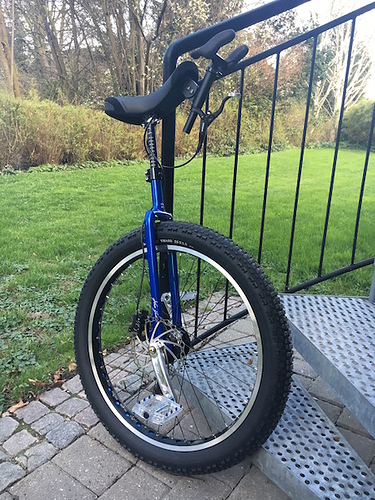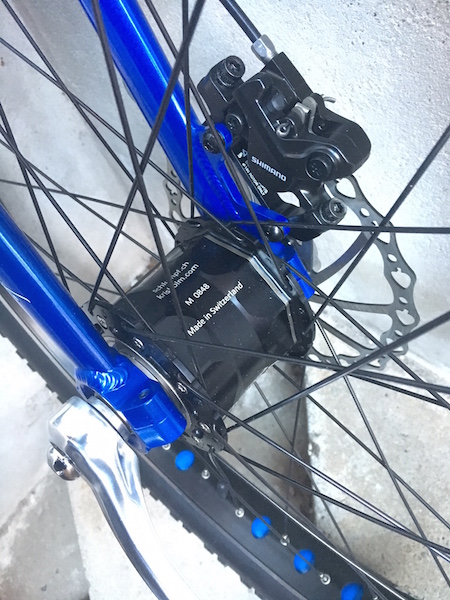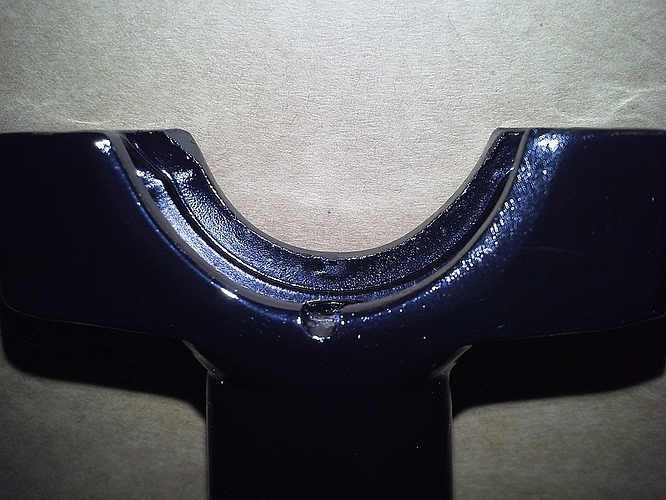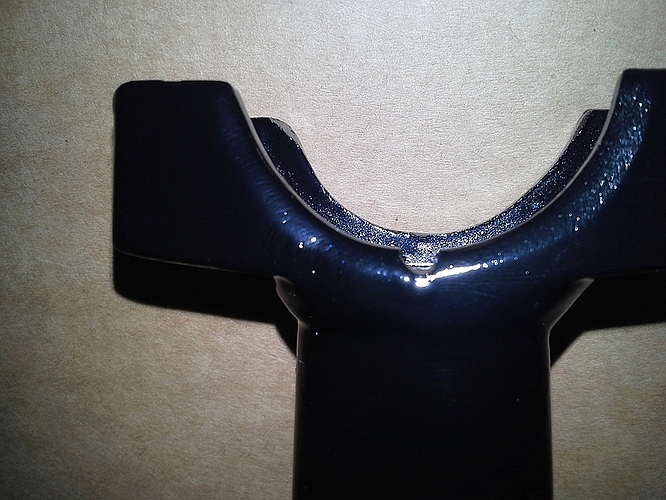Another urban ride with my g27, but during the last 30 min I was hearing the same bearing noise that you can hear when you have rode à bike or à pair of rollers under the Rain, which I did à little last week with this guni.
Has it happened to some of you guys and what did you do to fix it?
If it was an unguni I would simply add some grease to the bearings but the shlumpf hub is not as simple.
yep- remove the grub screw and squirt in some grease. Actually sounds easier than an Unguni- don’t even need to touch the bearing caps 
Note that a guni- even a perfectly functioning one- will have a certain amount of feedback that you feel/hear through the cranks/frame as opposed to a Unguni.
Note: sometimes bad noises are just grit and dust gathering on the outside of the hub body/dust caps and squeaking against the inside of the bearing holders- a damp cloth will sort that out. Or if it is a re-occurring problem, hit the inside welds on our bearing holders with a belt sander/file to make a little extra clearance.
Mark
Thanks for the help.
About putting more grease through the hole I already have put about two syringes in since I have my g26 (was clearly missing some), will probably try something else before doing it again but why not? I have 4 syringes left.
Will maybe have to take a closer look to the bearings, this video from terry gave me some ideas
I’ll do it When have the time, a clips remover and some high quality bearing grease.
Another gentle help from terry 
I discovered than my spokes were extremely loose, even looser than when I bought it (second hand).
So I decided to tight them all by comparing their sound to the spokes from my other wheels, but since I’m aware that tightening them too much can damage the hub I was a bit worry cause I didn’t know how much I could tighten them. (I have no tool to measure the spokes tension)
My goal was to have a reference sound for all the spokes and then truing my wheel by usual techniques, so I asked terry if he could record himself pinching few spokes from his own g26 and he did, which I appreciated very much.
It appears that the reference tone that I chose intuitively was close, maybe one or two half tones lower than terry’s audio, so it should be ok and I decided to start the truing work.
My g27 is now ready for a test, I also added another syringe of grease, but should now stop to add some for a long time.
I’ll see if the strange sound was coming from the spokes that where too loose.
Hey a question for those who are having trouble shifting, due to small feet.
How many of you are heel shifting (not ankle shifting).
It requires more precision but arguably has good potential to work for smaller feet. In other words:
- As your shifting foot passes through the forward part of the pedal stroke, let it come slightly off the pedal so you can move it backwards and move the heel inwards;
- As your foot passes forward on the next rotation catch the shifter button with your heel; and then
- On the next forward rotation adjust your foot back to normal pedalling.
Total - 2 rotations to shift and return your foot to normal pedaling. It seems onerous to write, but is a minor adjustment in practice.
I have size 10 feet. It feels like my shoe size could be at least as small as size 8 and have this still work comfortably on 150 mm cranks.
Also note the fact that some shoes have heel blocks that are much better for ankle shifting than others. Too sharp and blocky makes you catch the cranks; too rounded and it’s hard to shift. Five Ten Impacts (various models) generally have good heel blocks for shifting.
I have pretty small feet and I’m using shoes EU size 40 or 41, which converts to US sizes 7.5-8.5 and British sizes 7-8, but I’m still able to shift with my heel at 150 mm cranks.
It is not that very easy as I need to move my feet considerably, but you can get used to it. And shoes make big difference. In 5-10s it’s just a small foot movement, while in sandals or converse style shoes you need quite a move, but I ride in all of them and shift. So try and practice and practice 
Finally gave a quick test after having tightened and trued my g26 wheel (and added a syringe of grease).
No more noise, neither the “bearing after rain” noise, nor the indescribable mechanic noise I used to hear sometimes.
Don’t know why the spokes were so loose when I got the guni (the sailor said that the wheel had been built by a professional) but this leaded to a tendency of the spokes to easily become even looser, and to produce weird sounds.
I didn’t have my five-tens under hands (very hard to ankle shift without those since I have pedal extenders), so no proper shifting test to see if the new spoke tension affected the process, but I managed to shift 4 or 5 times in second gear anyway and it seamed to work well.
Don’t know if this is psychological but I had this feeling that my guni is now a bit easier to ride, especially in 2nd gear.
So, not late summer as announced, but here it is (shall be in the mail tomorrow or on monday:)):
Hope to complete the whole Uni (QX G27.5+ XC touring Muni) next week.
Finally!
Mine came a few days ago… Went for a first test ride today, wow! That was just riding around on the street, but I can definitely see the potential once I will have tamed the beast!
Riding in high gear was different but will get used to it. Not sure how rideable it will be in high gear offroad as it felt quite a bit harder than riding the 36", but it came with the wrong cranks (137mm), so I hope with the 150mm I’ll have a good chance at making it work.
A question though: from what I have read in the past (and Kris’ recent post in this thread is aligned with that), it sounds like shifting with the ankle is barely seen as a workaround if you cannot shift with your heels. Why is that? I practiced shifting in my test ride and I kept doing it with my ankles. I have small feet (41 EUR), but that would work equally well with larger feet, so why is this not the “norm”? (for those riding with high-ankle shoes - I always ride with my 5/10s).
At the moment, I would say I manage the upshift 90% of the time, and the down shift 50-70% so I am no longer planning to learn to shift with the heels (and I am less worried about the 150mm cranks when I get them). Sounds more cumbersome having to move your feet one revolution before shifting and then again after shifting. 
Oh, and the pictures… 
Teddy
Another g26 with the knard, that’s cool!
You will probably like it even more with the 150s that give more controle.
For road and street 35 to 30 psi is good, for off road you can experiment with the 15-25 psi range.
Enjoy!
Ankle shifting might actually be the ‘norm’ because it’s easier to learn and it’s not so much that one is better than the other. I mostly ankle shifted for the first couple of years of using a geared hub.
Ideally it’s good to know how to do both. That said, most riders that I know (including myself) who learn to heel-shift eventually come to see ankle shifting as a backup. As someone who rides on a geared hub every single day, often more than once per day, it just feels more precise and it is nice to have a shifting method that’s not so tied to a certain kind of shoe. Offroad, it’s nice to have ankle shifting as a backup if you miss on the heelshift because it’s harder to be precise when shifting when pedalling over bumpy terrain.
On my frame (modified QX) the gap between the two halfes of the bearing holder is as wide as the thickness of theese blocks. The would have gone lost. So I ground a groove right in the middle of the upper half. Now I can install the hub with the block vertical.
Great - can you post a photo?
Thank you for this validation. I openly self-identify as a low-to-intermediate level rider, and although I can heel shift (that’s how I started out), my success rate shot way up when I switched to ankle shifting, and that’s now my standard.
When my skill/confidence level eventually gets high enough, perhaps I’ll concentrate on heel shifting again. (It has occurred to me that a combination of ankle upshifts and heel downshifts may possibly be the ideal combination. For me, anyway.)
Cheers!
Even once
Even once doing a mile or 2 on the schumpf I’m not as comfy thereon as i’m on my short cranked 36". This being same, I LOVE it. it’s a serious toy and that i very fancy riding it… the sensation you get once you get within the groove with it’s wonderful. thanks Florian.
Thanks.
For anyone else who tries this approach: note that the protruding nubs are not centered on the bearing. They are slightly closer to the side of the knurled bearing that is laser etched with “UP”. As such - the ground location would need to be positioned to fit.
Kris
As there is space between the halfes of my bearing holders, a second groove would move when tightening the bearing holder. It would nearly be impossible to tighten it and keep it centered to the block at the same time. Making the groove wider would solve this issue, but would also make the second block idle as it would not block anything.
So I only use one of the blocks in my setup, which is the one on the upper side (frame side). I made only a groove in the frame, and not in the cap. One shall be enough to make slipping impossible as it is form fit.
Kris, as you say ankle shift is a backup, then my question is if you are able to ankle shift on the same rotation if you missed the heel shift? Then it would be really useful skill.




